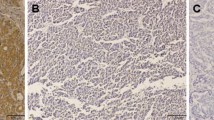Abstract
Purpose
The progression of hepatocellular carcinoma (HCC) is multifactorial and angiogenesis plays a fundamental role, mainly because HCC is a highly vascularized tumor.
Methods
In this study, we determined microvessel density (MVD) using the immunohistochemical markers, CD34 and CD105 (Endoglin), in 44 hepatectomy specimens, encompassing 44 malignant nodules (HCC), 44 regenerative nodules (RN), and 15 dysplastic nodules (DN). The evaluation included the determination of MVD in all nodules. For statistical analysis, a descriptive analysis was carried out using measurements of position and dispersion for continuous variables; ANOVA was used to compare between groups, considering p < 0.05 as statistically significant.
Results
We observed a significant difference when comparing CD34 and CD105 immunoexpression in HCC, DN, and RN. CD105 was predominantly expressed in the peripheral regions in HCC, with mean MVD scores of 6.2 ± 4.1 and 10.7 ± 4.4 at the center and periphery of the nodules, respectively, with significant differences between groups (p < 0.0001). CD34 had higher mean MVD scores than CD105 in HCC, with a more uniform positivity pattern. CD105 immunoexpression in DN exhibited a pattern similar to HCC. However, in RN, CD105 exhibited a higher MVD score in the central portion of the nodules. CD105 was expressed in a subset of newly formed microvessels in HCC and demonstrated an elevated mean MVD in cirrhotic or regenerative nodules.
Conclusions
MVD determined by CD34 and CD105 expression may be used as an additional parameter to distinguish benign from malignant liver nodules.



Similar content being viewed by others
References
Tsukuma H, Hiyama T, Tanaka S, Nakao M, Yabuuchi T, Kitamura, et al. Risk factors for hepatocellular carcinoma among patients with chronic liver disease. N Engl J Med 1993;328(25):1797–1801
El-Serag HB, Rudolph KL. Hepatocellular carcinoma: epidemiology and molecular carcinogenesis. Gastroenterology 2007;132(7):2557–2576
Theise ND, Park YN, Curado MP, et al. Hepatocellular carcinoma. In: Bosman FT, Carneiro F, Hruban RH, Theise ND, editors. WHO Classification of Tumours of the Digestive System. Lyon: IARC Press; 2010. 205–216
Theise ND, Park YN, Kogiro M. Dysplastic nodules and hepatocarcinogenesis. Clin Liver Dis 2002;6(2):497–512
Villanueva A, Newell P, Chiang DY, Friedman SL, Llovet JM. Genomics and signaling pathways in hepatocellular carcinoma. Semin Liver Dis 2007;27(1):55–76
Pang RW, Joh JW, Johnson PJ, Monden M, Pawlik TM, Poon RT. Biology of hepatocellular carcinoma. Ann Surg Oncol 2008;15(4):962–971
Hytiroglou P. Morphological changes of early human hepatocarcinogenesis. Semin Liver Dis 2004;24(1):65–75
Park YN, Yang CP, Fernandez GJ, Cubukcu O, Thung S, Theise ND. Neoangiogenesis and sinusoidal “capillarization” in dysplastic nodules of the liver. Am J Surg Pathol 1998;22(6):656–662
Semela D, Dufour JF. Angiogenesis and hepatocellular carcinoma. J Hepatol 2004;41:864–880
Deli G, Jin CH, Mu R, Yang S, Liang Y, Chen D, et al. Immunohistochemical assessment of angiogenesis in hepatocellular carcinoma and surrounding cirrhotic liver tissues. World J Gastroenterol 2005;11:960–963
International Working Party. Terminology of nodular hepatocellular lesions. Hepatology 1995;22(3):983–993
Hytiroglou P, Park YN, Krinsky G, Theise ND. Hepatic precancerous lesions and small hepatocellular carcinoma. Gastroenterol Clin N Am 2007;36:867–887
International Consensus Group for Hepatocellular Neoplasia. Pathologic diagnosis of early hepatocellular carcinoma: a report of the international consensus group for hepatocellular neoplasia. Hepatology 2009;49(2):658–664
Roncalli M, Borzio M, Di Tommaso L. Hepatocellular dysplastic nodules. Ann Ital Chir 2008;79(2):81–89
Sakamoto M, Effendi K, Masugi Y. Molecular diagnosis of multistage hepatocarcinogenesis. Jpn J Clin Oncol 2010;40(9):891–896
Shiraha H, Yamamoto K, Namba M. Human hepatocyte carcinogenesis (review). Int J Oncol 2013;42(4):1133–1138
Folkman J. Tumor angiogenesis: therapeutic implications. N Engl J Med 1971;285(21):1182–1186
Folkman J. Tumor angiogenesis. Adv Cancer Res 1985;43:175–203
Folkman J, Shing Y. Angiogenesis. J Biol Chem 1992;267(16):10931–10934
Frachon S, Gouysse G, Dumortier J, Couvelard A, Nejjari M, Mion F, et al. Endothelial cell marker expression in dysplastic lesions of the liver: an immunohistochemical study. J Hepatol 2001;34(6):850–857
Di Carlo I, Fraggetta F, Lombardo R, Azzarello G, Vasquez E, Puleo S. CD34 expression in chronic and neoplastic liver diseases. Panminerva Med 2002;44(4):365–367
Yang L, Lu W, Huang G, Wang W. Correlation between CD105 expression and postoperative recurrence and metastasis of hepatocellular carcinoma. BMC Cancer 2006;6:110
Nakamura T. Changes in expression of bile canalicular CD10 and sinusoidal CD105 (endoglina) in peri-tumoral hepatic tissue. Tumori 2009;95(4):495–500
Wang Y, Zhang XH, Guo P, Yan LN, He D. Tumor microvascular density detected by anti-CD105 and anti-CD34 in hepatocellular carcinoma patients and its predictive value of tumor recurrence after liver transplantation. Sichuan Da Xue Xue Bao Yi Xue Ban 2010;41(5):818–882
Ho JW, Poon RT, Sun CK, Xue WC, Fan ST. Clinicopathological and prognostic implications of endoglin (CD105) expression in hepatocellular carcinoma and its adjacent non-tumorous liver. World J Gastroenterol 2005;11(2):176–181
Yu D, Zhuang L, Sun X, Chen J, Yao Y, Meng K, et al. Particular distribution and expression pattern of endoglin (CD105) in the liver of patients with hepatocellular carcinoma. BMC Cancer 2007;7:122
Wang ZS, Wu LQ, Yi X, Geng C, Li YJ, Yao RY. Connexin-43 can delay early recurrence and metastasis in patients with hepatitis B-related hepatocellular carcinoma and low serum alpha-fetoprotein after radical hepatectomy. BMC Cancer 2013;13(1):306
Compliance with ethical requirements and Conflict of interest
This study entitled was approved by the Ethics and Research Committee at the institution where it was held (Faculty of Medical Sciences, State University of Campinas, Sao Paulo) with registration number 638/2006. All procedures followed were in accordance with the ethical standards of the responsible committee on human experimentation (institutional and national) and with the Helsinki Declaration of 1975, as revised in 2008. Vanderlei Segatelli, Ebe Christie de Oliveira, Elaine Cristina de Ataide, Ilka de Fatima Santana Ferreira Boin and Cecilia Amelia Fazzio Escanhoela declare that they have no conflict of interest
Author information
Authors and Affiliations
Corresponding author
Rights and permissions
About this article
Cite this article
Segatelli, V., de Oliveira, E.C., Boin, I.F.S.F. et al. Evaluation and comparison of microvessel density using the markers CD34 and CD105 in regenerative nodules, dysplastic nodules and hepatocellular carcinoma. Hepatol Int 8, 260–265 (2014). https://doi.org/10.1007/s12072-014-9525-9
Received:
Accepted:
Published:
Issue Date:
DOI: https://doi.org/10.1007/s12072-014-9525-9




